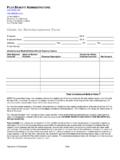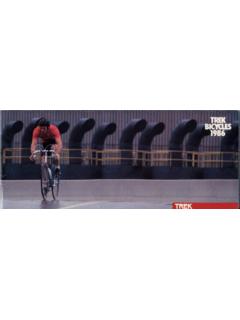Transcription of FOR ANY TYPE AND SIZE OF CYLINDER - BRM Flex-Hone ...
1 BRUSH RESEARCH MANUFACTURING CO., ANY TYPE AND size OF CYLINDER Instructions For UseHoningDeburringFinishingThe Flex-Hone tool should be securely held in a collet, chuck, or similar holding device. It is best to use the shortest shank possible for your application. The Flex-Hone tool should be well coated with lubricant and rotating prior to entry and should continue rotating until fully removed from the part. The tool can be run from 60 to 1200 RPM, depending on tool diameter. The smaller the diameter, the higher the spindle speeds. Start with a spindle speed between 500-800 RPM.
2 You may need to experiment to find the optimum speed for your application. Never exceed 1200 Flex-Hone tool must always be used with a good quality cutting oil or honing fluid to keep heat to a minimum, prevent the tool from loading and to suspend the material being removed. The Flex-Hone tool should have a continuous stroke rate between 120 to 180 inches per minute. Final stroking may be accelerated to develop a 45 crosshatch finish. Use the minimum honing time needed to achieve the required finish. Average honing time is 10-25 seconds, (5-15 strokes).
3 Clean the CYLINDER using hot, soapy water and brush the CYLINDER wall with a cleaning brush. Dry the CYLINDER and continue to clean with a lint free cloth coated with a light oil or mineral spirits. Continue to clean until the lint free cloth remains types 20 40 60 80 120 180 240 320 400 600 800SC = Silicon Carbide X X X X X X X X X X XAO = Aluminum Oxide BC = Boron Carbide WC = Tungsten Carbide (either 100% or 50/50)Z Grain - Alumina ZirconiaNo.
4 1525 (25% Zirconia/75% Alumina)Z Grain - Alumina ZirconiaNo. 1549 (40% Zirconia/60% Alumina)Diamond Diamond is available in mesh 170/200, 800 and 2500 Levigated Alumina X X X X X X X X X X X X X X X X X X X X X X X X X X X X X X X X X X X X X X X Available in extra fine grit onlyGrit
5 SizesSTANDARDFlex-Hone Benefits Include:SURFACE FINISHINGThe Flex-Hone Tool is available in a variety of abrasive types and grit selections to provide the optimum surface finish on any base material. The Flex-Hone is commonly used to reduce Ra, Rk and Rpk values while maintaining Rvk and Vo volume for oil retention. Using the Flex-Hone Tool for surface finishing allows the sizing tools to do their jobs quickly and accurately without fighting surface finish. The Flex-Hone is also used in adhesive bonding applications where a rougher surface is desired for bonding integrity.
6 DEBURRINGD eburring of cross drilled holes is an expensive, time consuming operation. The Flex-Hone Tool can be used to remove burrs from cross drilled holes leaving a clean, radiused intersection. Because of its unique construction, the Flex-Hone can be used online in machine tool applications or offline as a secondary operation. The tool is self-centering and self-aligning to the bore so elaborate, rigid set-ups are not required. It is advisable to use the tool in the main bore into which the cross holes break. Best results are obtained by rotating and stroking the tool a few strokes in a clockwise direction, removing the tool from the part, reversing the spindle and then rotating and stroking the tool in a counter clockwise direction for a few more strokes.
7 This forward and reverse rotation creates a more symmetrical deburring FINISHING Brush Research pioneered the concept of a plateau finish and is a strong proponent of the benefits of a cross hatch, plateaued finish. The concept involves removing the peaks produced by prior machining operations and creating a substantially flat or plateau finish. A plateau finish created by the elimination of peaks allows rings and seals to seat without damaging their edges. The cross hatch pattern will aid in lubrication control and retention, reduce seepage in hydraulic and pneumatic applications and promote longer seal life.
8 Abrasive/Grit OptionsNEED HELP SELECTING THE RIGHT Flex-Hone ? We have technical assistance available during our regular business hours. Please call (323)261-2193 or email to get assistance with any of your applications. Also, see our How to Order a Flex-Hone section on the website.









